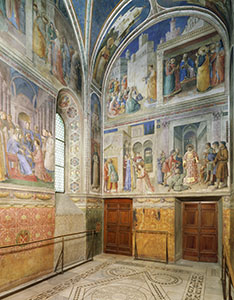
Interior of the Niccoline Chapel, Vatican Palace.
Pope Nicholas V (1447-1455) commissioned this Chapel between 1448 and 1449 to the Dominican monk Guido di Pietro, known as "il Beato Angelico" (the Blessed Angelic One), who carried out the work with the help of some co-workers.
The walls were painted with episodes from the lives of Saint Stephen and Saint Lawrence which highlighted the serene virtues of the Pope - eloquence and charity, in particular - through the qualities of these martyrs. Angelico may have been a painter but, first and foremost, he was a Dominican monk, and he expressed his vocation and genuine piety through the colours used in his painting, not least in these works.
This cycle honoured the Catholic Church through the faith passed down by the Apostles and by the parallel lives of these two deacon martyrs of the Churches of Jerusalem and Rome: Stephen, a contemporary of Christ, and Lawrence, a contemporary of Christ’s Vicar, Sixtus II. The life of Saint Stephen was depicted according to the biblical story from the Acts of the Apostles, while the story of Saint Lawrence was based on Jacobus de Varagine’s Golden Legend.
The Church - the universal sacrament of salvation - is symbolically represented by the fourteen patriarchs and the prophets of the Old Testament, reaching out towards Christ, while the historical event of the Redemption is portrayed by the four Evangelists frescoed on the ceiling. Eight Doctors from the Eastern and Western Churches are painted on the pillars, expressing the two-fold (sanctifying and evangelising) mission of the very Church they uphold.
Thanks to the publication of a book on the restoration work carried out between 1996 and 1997, scholars - with not inconsiderable reservations - were able to establish Benozzo’s important role in the painting of these frescoes, as confirmed by the artist's style and the title of "dipintore" (painter) cited in the surviving commission contract. Benozzo’s involvement relates predominantly to the stories of Saint Stephen that decorate the lunettes and, in particular, the episode illustrating the Ordination of the Martyr. His involvement in the scenes depicting the stories of Saint Lawrence, on the other hand, appears very limited.
The chapel maintained the characteristics of a "private oratory" until the latter half of the fifteenth century, when its functions were transferred to other parts of the Vatican Palace.
Serena Nocentini